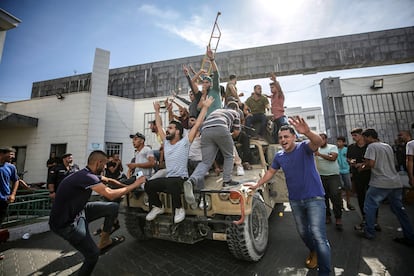What is Hamas and who is behind the Palestinian militant group?
According to several intelligence services, Iran — whose shadow looms over the attack on Israel — has provided money, weapons and military training to the fundamentalist militia since the 1990s

Hamas launched an unprecedented attack against Israel on Saturday. The death toll, between Palestinians and Israelis, has now reached 1,300. The Palestinian militant group — which has been at war with the Jewish state since the 1990s — has never before been able to carry out an offensive of this magnitude. It was able to penetrate several points of Israel’s fortified border with Gaza, infiltrate hundreds of its militants into Israeli territory and return to the Gaza Strip with hundreds of Israeli hostages. So what is Hamas, and what is its stance towards Israel? Who authorized and financed the attack? And who trained them? EL PAÍS reviews what is known about the answers to these questions.
What is Hamas?
Hamas is the Arabic acronym for “Islamic Resistance Movement,” and was founded in 1987, during the early days of the Palestinian Intifada against the Israeli occupation of the West Bank and the Gaza Strip. The fundamentalist Islamic group won the 2006 elections by an absolute majority and expelled Fatah, the organization that formed the founding core of the Palestine Liberation Organization (PLO). And since 2007 — two years after the Israeli withdrawal from Gaza — it has been the de facto ruler of the Gaza Strip.
The ideology of both factions of the Palestinian national movement is very different: Hamas is a radical Islamist movement, which aspires to impose Islamic law. Fatah, founded by Yasser Arafat in the late 1950s, is secular and nationalist. The main difference between the two is, however, not ideological, but political: Fatah and the PLO agreed to renounce the armed struggle after the 1993 Oslo Accords and to negotiate with Israel, while Hamas does not even recognize Israel as a state. Fatah and the Palestinian National Authority (PNA) govern the West Bank, while Hamas administers Gaza. Negotiations to reconcile both factions, the most recent in 2017, have not borne fruit.
What is Hamas's stance towards Israel?
In addition to its goal to establish an Islamic society based on Sharia law, Hamas’s founding charter includes another objective: to destroy the state of Israel and make Jerusalem — the third-holiest place in Islam — the capital of Palestine. This Palestinian militant group and its armed wing, the Izz ad-Din al-Qassam Brigades, declared war on Israel in the early 1990s and have since attacked that country with rockets and suicide attacks. It has also kidnapped Israeli citizens. Israel has not only responded with several military campaigns — the 2020 offensive killed more than 2,200 Palestinians, most of them civilians — but also assassinated several militia leaders, such as its co-founder, Sheikh Ahmed Yasin, who was killed in 2004.
Who finances Hamas now?
Although Hamas has had different sponsors since its founding, including Syria and Saudi Arabia, Israeli and U.S. intelligence services believe that its main supporter is now Iran, although Tehran has provided money, weapons and training since the late 1980s. Iran is a Shiite regime, the minority branch of Islam, while Hamas is Sunni. However, both have the motto “Death to Israel” among their ideological pillars. In April, Israeli Defense Minister Yoav Gallant estimated that Iran was giving Hamas $100 million a year, as well tens of millions of dollars to Gaza’s second-largest fundamentalist group, Islamic Jihad, which also participated in Saturday’s attack. But that money is barely enough to maintain the suffocated administration of the Gaza Strip — which has been subject to a total blockade by Israel for 16 years — and several analysts have suggested the real figure is much higher.
Who authorized and financed the attack?
The Wall Street Journal on Sunday quoted Hamas officials who confirmed that Iran approved the attack last Monday in Beirut. Iran denies this, but there are indications that it at least knew the operation was going to take place. Last Wednesday — three days before the Hamas attack on Israel — Iran’s supreme leader Ali Khamenei posted: “The Zionist regime [Israel] is dying” in a pinned message on X (formerly Twitter). On June 21, Khamenei received a delegation chaired by Gaza Prime Minister and Hamas leader Ismail Haniyeh, which also included Ziyad al-Nakhalah, secretary general of Islamic Jihad. After the attack, the Iranian president, the ultra-conservative Ebrahim Raisi, congratulated Haniyeh by phone. Before Hamas launched the attack, some buildings in Tehran had been covered with huge banners alluding to the “Al-Aqsa Storm” operation, which is what the Palestinian militants called the offensive.
The Zionist regime is dying
— Khamenei Media (@Khamenei_m) October 4, 2023
Imam Khamenei
Oct. 3, 2023#Palestine 🇵🇸 pic.twitter.com/PWQ8MkzBHi
Has Hamas recognized Iranian help?
Yes. On Sunday, Abu Obeida, the spokesperson for the Izz ad-Din al-Qassam Brigades thanked Iran for “providing them with money, weapons, missiles and anti-tank artillery” for the attack. In a statement from its mission to the U.N., Iran denied on Monday that it was involved in the Palestinian offensive, although it reiterated that it supports the operation.
Who trained Hamas militants?
Israeli and Western intelligence services maintain that Hamas militants have been trained by Iran, through another of its allies in the region: the Lebanese Shiite party Hezbollah. The Lebanese militant group, in turn, receives training from Quds Force (Jerusalem Force). This is an elite unit of the Revolutionary Guard, which is a parallel army to the regular force. The main task of the Revolutionary Guard is to protect the Islamic regime. According to the Israeli Defense Minister, Iran gives Hezbollah at least $700 million a year. Members of Hamas and Islamic Jihad have been trained militarily by Hezbollah in training camps in Iran. According to the intelligence services of Arab countries, the United States and Israel, the Lebanese party has also served as an intermediary to send Iranian weapons to Hamas.
Why has this attack taken place now?
Analysts believe the attack was pushed forward to dissuade Saudi Arabia from establishing diplomatic relations with Israel. The attack was surely already planned, and would have required months of preparation. Another reading is that Hamas and its allies sought to take advantage of the perceived weakness of the Israeli government, which has been hit with mass protests over its controversial judicial reform. If it is confirmed that Iran took part in the attack, there is another possible hypothesis: it may be linked to Iran’s internal politics. The section of the population that still supports the Islamic Republic of Iran — a shrinking social base due to the repression of the latest anti-regime protests —, has been indoctrinated to reject Israel and welcomes Tehran’s support for Palestinian fundamentalist movements.
Sign up for our weekly newsletter to get more English-language news coverage from EL PAÍS USA Edition
Tu suscripción se está usando en otro dispositivo
¿Quieres añadir otro usuario a tu suscripción?
Si continúas leyendo en este dispositivo, no se podrá leer en el otro.
FlechaTu suscripción se está usando en otro dispositivo y solo puedes acceder a EL PAÍS desde un dispositivo a la vez.
Si quieres compartir tu cuenta, cambia tu suscripción a la modalidad Premium, así podrás añadir otro usuario. Cada uno accederá con su propia cuenta de email, lo que os permitirá personalizar vuestra experiencia en EL PAÍS.
¿Tienes una suscripción de empresa? Accede aquí para contratar más cuentas.
En el caso de no saber quién está usando tu cuenta, te recomendamos cambiar tu contraseña aquí.
Si decides continuar compartiendo tu cuenta, este mensaje se mostrará en tu dispositivo y en el de la otra persona que está usando tu cuenta de forma indefinida, afectando a tu experiencia de lectura. Puedes consultar aquí los términos y condiciones de la suscripción digital.
More information
Archived In
Últimas noticias
Most viewed
- Sinaloa Cartel war is taking its toll on Los Chapitos
- Oona Chaplin: ‘I told James Cameron that I was living in a treehouse and starting a permaculture project with a friend’
- Reinhard Genzel, Nobel laureate in physics: ‘One-minute videos will never give you the truth’
- Why the price of coffee has skyrocketed: from Brazilian plantations to specialty coffee houses
- Silver prices are going crazy: This is what’s fueling the rally











































